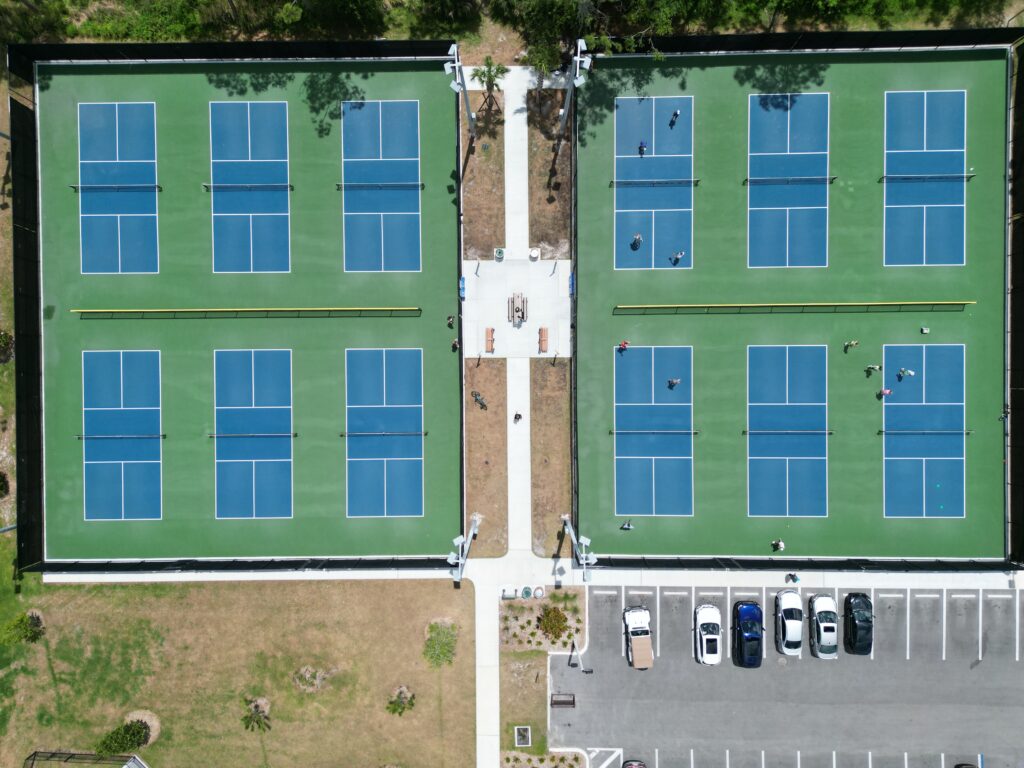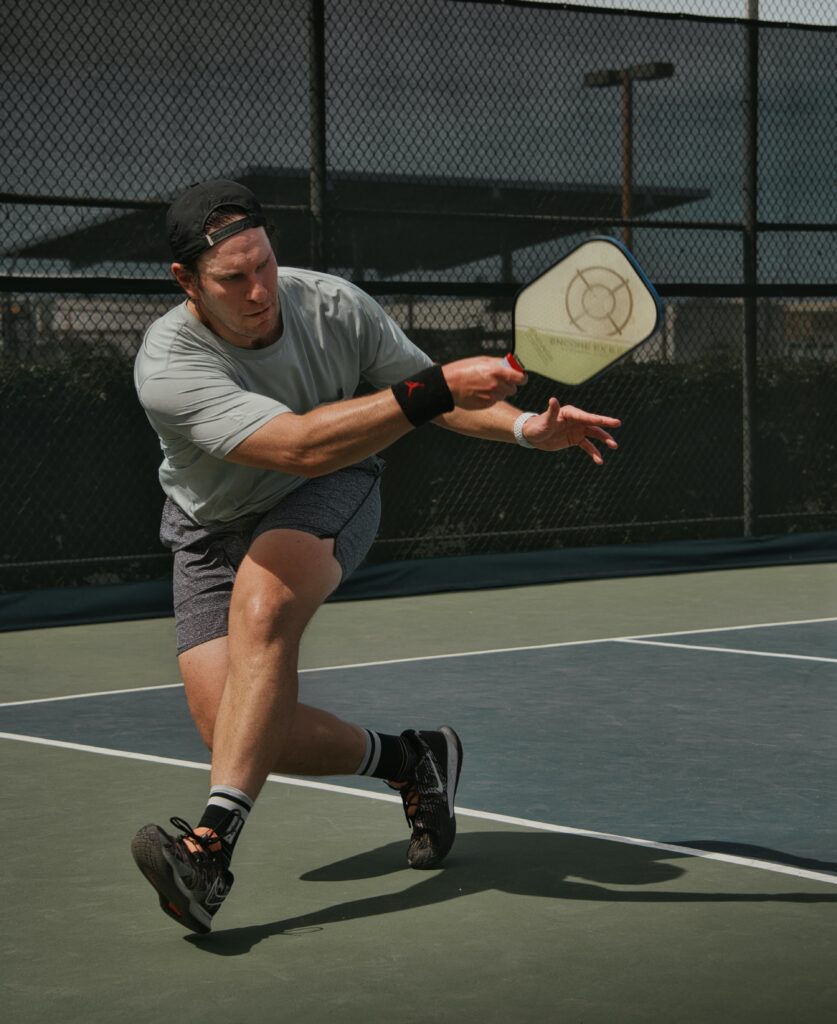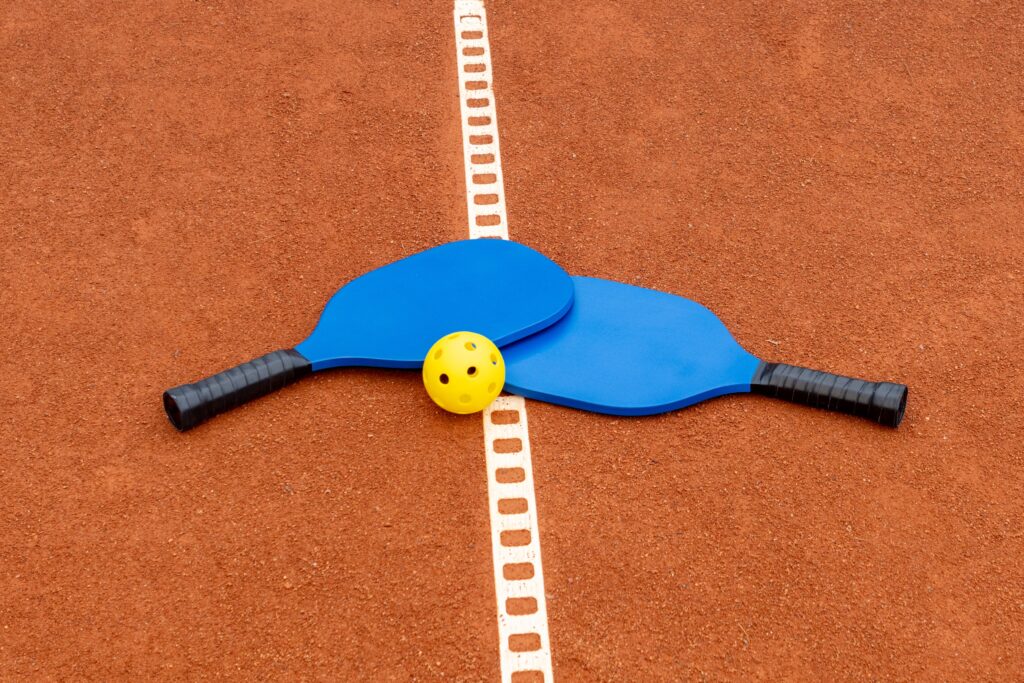Are you ready to dive into the exciting world of pickleball? Look no further! In this article, we will explore the essential rules and scoring system of this popular sport. Whether you are a seasoned player looking for a refresher or a complete newbie eager to learn, this guide is here to help. Get ready to bring your agility, strategy, and competitive spirit as we unravel the ins and outs of pickleball rules and scoring. Let’s jump right in!
Basics of Pickleball
What is pickleball?
Pickleball is a popular racket sport that combines elements of tennis, badminton, and ping pong. It is played on a rectangular court, and the objective is to hit a perforated plastic ball over the net and land it within the boundaries of the opposing team’s court. The game can be played in singles or doubles format and provides a fun and engaging way to stay active and socialize with friends and family.
Court dimensions
Pickleball courts are 20 feet wide by 44 feet long for both singles and doubles play. The net is positioned at the center of the court, measuring 36 inches in height at the sidelines and 34 inches in height at the center. The court is divided into two equal halves by the net, and each half is further divided into two service areas and two non-volley zones. These dimensions ensure a fair and balanced playing field for all participants.
Equipment needed
To play pickleball, you will need some basic equipment. This includes a pickleball paddle, which is similar to a larger version of a ping pong paddle, and a perforated plastic ball, which is smaller and lightweight compared to a tennis ball. It is essential to choose the right paddle that suits your style of play and provides a comfortable grip. Additionally, wearing appropriate footwear and comfortable clothing will enhance your performance and reduce the risk of injuries.
Number of players
Pickleball can be played in both singles and doubles formats. In singles play, it is a one-on-one game where each player competes against the other. In doubles play, two teams of two players each face off against each other. The game is highly flexible, allowing players to choose the format that suits their preferences and the number of participants available. Whether you prefer the intensity of singles or the camaraderie of doubles, pickleball caters to all player preferences.
Pickleball Rules
Serving
The serve is the beginning of each rally in pickleball. The server must stand behind the baseline and hit the ball diagonally across the net to the opponent’s service court. The serve must land within the opponent’s service court and clear the non-volley zone during the initial serve. Both feet of the server must remain behind the baseline during the serve until contact is made with the ball. If the serve is successful, the server’s team will earn a point and continue serving until a fault occurs.
Double bounce rule
The double bounce rule is an important aspect of pickleball gameplay. According to this rule, both teams must let the ball bounce once on each side before volleying it. This ensures fairness and allows players to have an opportunity to reach the ball after the serve. However, after the two bounces have occurred, players can volley the ball in the air without letting it bounce. The double bounce rule adds an extra layer of strategy to the game and encourages players to anticipate the ball’s trajectory.
Faults
In pickleball, certain actions or mistakes result in faults, which award points to the opposing team. Faults can occur during the serve, return of serve, or during the rally. Common faults include hitting the ball out of bounds, failing to clear the net, stepping into the non-volley zone while volleying the ball, and committing foot faults. It is essential to be aware of the rules and avoid these faults to maximize your team’s chances of scoring points and winning the game.
Non-volley zone
The non-volley zone, also known as the kitchen, is a critical area of the pickleball court. It is a seven-foot zone on both sides of the net and extends back to a line that is 15 feet away from the net. Players are not allowed to hit the ball in the air (volley) while standing inside this zone unless the ball has bounced once on each side of the net. The non-volley zone rule prevents players from dominating the game by constantly volleying near the net and promotes longer rallies and strategic shot placement.
Let serve
A let serve occurs when the ball hits the top of the net during the serve but still lands within the opponent’s service court. In such cases, the serve is replayed without any penalties, and the server gets another chance. Let serves add an element of unpredictability to the game, as the ball’s trajectory can change drastically after hitting the net. However, if the ball hits the net and goes out of bounds or fails to land within the service court, it is considered a fault.
Rotation
In doubles play, players must rotate their positions on the court during each service turn. After the serving team loses the rally and the opposing team earns the serve, players on the serving team must shuffle or switch sides. In other words, the player who served the ball initially will now be the receiver, and their teammate will take over as the server. This rotation ensures fairness and equal distribution of opportunities for all players, enhancing the overall experience of the game.

Scoring in Pickleball
Points system
Pickleball uses a rally scoring system, which means that points can be scored by both the serving and receiving teams. Each time a team wins a rally, they are awarded a point. In doubles play, each server serves both points until a fault occurs, and then the serve passes to the opposing team. In singles play, servers alternate serving after each point. All points are counted regardless of which team served, allowing for exciting comebacks and close matches.
Winning the game
To win a pickleball game, a team must reach a specific number of points first. Typically, games are played to 11 points, but some variations may use a different target score, such as 15 or 21 points. However, the winning team must also have a lead of at least two points. If the score reaches a tie at 10-10 (or 11-11 in some cases), a tiebreaker is played to determine the winner. The tiebreaker has its own specific rules, which we will explore later in this article.
Switching sides
In doubles play, players switch sides of the court when either team reaches a total of six points in the current game. This ensures that neither team has an unfair advantage due to factors such as sun, wind, or court conditions. Players must change sides again when the score reaches 12 points to maintain fairness throughout the game. Switching sides allows players to adapt to different angles of the court and creates a level playing field for both teams.
Tie-breaker rules
When the score reaches a tie at 10-10 (or 11-11 in some variations), a tiebreaker is played to determine the winner. In the tiebreaker, teams only serve one point at a time, starting with the team that would have served next in the regular game. Each player on the serving team gets the opportunity to serve once. The team that wins the first rally in the tiebreaker will serve for the next point. The tiebreaker continues until one team reaches a lead of two points and is declared the winner.
Servicing Rules
Right serve box
When serving in pickleball, each server must start in the right serve box. The server must serve diagonally to the opponent’s service court, ensuring that the ball lands within the boundaries of the court. Failing to serve from the correct box or serving outside the service court results in a fault, awarding a point to the opposing team. It is important to be aware of your serving position and ensure your accuracy while serving to maximize your team’s chances of success.
Diagonal serve
Pickleball serves must be hit diagonally across the net, from the right serve box to the left service court for the opposing team. This diagonal serve rule ensures that the server does not have an unfair advantage by serving directly to the opponent or targeting a specific area of the court. By serving diagonally, players are challenged to strategize their shots and aim for specific areas of the opponent’s court, adding depth and excitement to the game.
Service sequence
In doubles play, each team has two different serving turns during each game. The serving sequence starts with the first server serving the first point. The server’s partner on the receiving side takes over as the server for the next point. After this, the serve rotates back and forth between the two players until a fault occurs. The serving sequence ensures that both players on each team have an equal opportunity to serve and contribute to their team’s success.
Service faults
Pickleball has specific rules regarding service faults to maintain fairness and consistency in the game. A service fault occurs when the server fails to hit the ball over the net, the serve lands outside the opponent’s service court, or the server commits a foot fault by stepping over the baseline too early. Additionally, the server must ensure that both feet remain behind the baseline until contact is made with the ball. Committing any of these faults awards a point to the opposing team and the serve changes hands.

Double Bounce Rule
What is the double bounce rule?
The double bounce rule in pickleball states that both teams must allow the ball to bounce once on each side before volleying it. This means that after the serve, the receiving team must let the ball bounce before returning it, and the serving team must allow the return to bounce as well. This ensures that both teams have a fair opportunity to reach the ball and promotes longer rallies. Once the ball has bounced twice, players can then volley it in the air without letting it bounce.
Exceptions to the rule
While the double bounce rule is generally followed in pickleball, there are a few exceptions to the rule. One exception occurs when the server successfully executes a drive serve, meaning the serve is hit with enough power and velocity that it reaches the receiver’s service court without bouncing. In this case, the receiving team is still required to let the ball bounce on their side before returning it. Another exception is when the serve is hit, and it touches the non-volley zone (the kitchen) without bouncing. In this scenario, the receiving team may volley the ball without waiting for it to bounce.
Faults in Pickleball
Foot faults
Foot faults are one of the common faults that can occur during pickleball gameplay. A foot fault occurs when the server or the returner moves or steps on or over the baseline before making contact with the ball. To avoid foot faults, it is essential to ensure that both feet remain behind the baseline until the ball is hit. Failing to do so results in a fault and awards a point to the opposing team, interrupting the serve or return sequence.
Volleying from non-volley zone
Another fault in pickleball occurs when a player volleys (hits the ball in the air without letting it bounce) while standing in the non-volley zone, also known as the kitchen. The non-volley zone is a critical area that extends seven feet on both sides of the net. Players are not allowed to volley the ball from within this zone, except in specific situations. To avoid this fault, players must be mindful of their position on the court and ensure they are outside the non-volley zone before hitting the ball in the air.
Hitting the ball out of bounds
Hitting the ball out of bounds is another fault in pickleball. The ball must land within the boundaries of the court, and any shots that go beyond the lines are considered out of bounds. This includes serves, returns, and shots during the rally. If the ball is hit out of bounds during gameplay, the opposing team is awarded a point, and the serve or return sequence switches to the other team. It is crucial to maintain accuracy and control during shots to avoid committing this fault.
Failure to clear the net
When hitting the ball in pickleball, it is essential to ensure that the ball clears the net and lands within the opponent’s court during the serve, return, or rally. Failing to hit the ball over the net results in a fault and awards a point to the opposing team. This fault can occur if the ball hits the net and fails to cross, hits the net and lands outside the opponent’s court, or if the ball is blocked or intentionally touched by the net while crossing. Paying attention to the height and trajectory of your shots is crucial to avoid this fault and maintain a strong position in the game.

Non-Volley Zone Rule
Definition of non-volley zone
The non-volley zone, often referred to as the kitchen, is an important aspect of pickleball gameplay. It is a seven-foot area on both sides of the net and extends back to a line that is 15 feet away from the net. The non-volley zone is marked by a line on the court to indicate its boundaries. Players are not allowed to volley (hit the ball in the air without letting it bounce) while standing within this zone unless the ball has already bounced on each side of the net. The non-volley zone rule encourages strategic shot placement and prevents players from dominating the game near the net.
Prohibited shots
When standing in the non-volley zone, players are restricted from hitting the ball in the air (volleying) until the ball has already bounced on each side of the net. This rule applies to shots such as smashing, overhead slams, and other powerful volleys. Players must wait for the ball to bounce on their side and the opponent’s side before they are allowed to volley. This rule aims to create a fair playing field and promote longer rallies by limiting the dominance of players near the net.
Exceptions to the rule
While the non-volley zone rule generally applies to all volleys within the zone, there are a few exceptions to the rule. One exception occurs when a player’s momentum carries them into the non-volley zone after they have made a legal return that has not crossed the net yet. In this case, the player is allowed to hit the ball, even if it is within the non-volley zone. Another exception is when the ball bounces in the non-volley zone, allowing players to hit the ball in the air without stepping out of the zone. These exceptions help maintain fairness and prevent unnecessary penalties in specific situations.
Let Serve Rule
Definition of let serve
A let serve occurs when the ball hits the top of the net during the serve but still lands within the opponent’s service court. When a let serves happens, it is considered a replay, and the server gets another chance to serve without any penalties. This rule accounts for the occasional unpredictable bounces that can occur off the net and ensures that servers are not unfairly penalized for factors outside of their control. Let serves add an element of surprise to the game, as the ball’s trajectory can change significantly after hitting the net.
Let serve during the game
Throughout the game, let serves can occur on both the first and second serves of each service turn. If the ball hits the net during the serve and still lands within the opponent’s service court, it is called a let serve, and the server gets another opportunity to serve. If the let serve occurs during the second serve, the server will get one additional opportunity to serve. However, if the ball hits the net during the first serve, and lands outside the opponent’s service court, it is considered a fault, and the serve changes hands to the opposing team.

Rotation in Doubles Play
Sequence of shots
In doubles play, the sequence of shots in pickleball follows a specific pattern. The serving team starts the rally with a serve, and the receiving team must return the ball. After the serve and return, both teams continue hitting the ball until the rally ends. The rally ends when one team fails to hit the ball over the net, commits a fault, or hits the ball out of bounds. The team that wins the rally earns a point and continues serving. The sequence of shots ensures that each team has an equal opportunity to serve and return, maintaining fairness throughout the game.
Switching courts
To maintain fairness and equal opportunities for both teams, players switch courts after each game when the score reaches a total of six points. This means that players from the serving team move to the opposite side of the court and switch places with their teammates from the receiving team. This rotation ensures that no team has an unfair advantage due to factors like sun, wind, or court conditions. Switching courts allows players to adapt to different angles of the court and creates a level playing field for both teams.
Rotation in singles play
In singles play, rotation is not necessary as there is only one player per side of the court. As the sole player, you will serve from the right serve box, and after each point, you will continue serving from the alternate side. This eliminates the need for court rotations, as there are no teammates to switch places with. Singles play offers a different dynamic, with players relying solely on their own skills and strategies to outplay their opponent.
Scoring System in Pickleball
Rally scoring
Pickleball uses a rally scoring system, which means that points can be scored by both the serving and receiving teams. Each time a rally ends, regardless of which team served, a point is awarded. This scoring system keeps the game fast-paced and ensures that every point counts. Whether serving or receiving, players must maintain focus and strive to win each rally to accumulate points and ultimately secure victory.
Winning points
In pickleball, points are won by successfully winning a rally. A rally is won when the opposing team fails to return the ball over the net, commits a fault, or hits the ball out of bounds. Regardless of whether it was the serving or receiving team that won the rally, a point is awarded to the winning team. Winning points are crucial to securing victory, and players must aim to consistently outperform their opponents in each rally.
Side out scoring
Side out scoring refers to the scoring system used in traditional pickleball games. In side out scoring, points can only be won by the serving team. If the receiving team wins a rally, they do not receive a point but instead gain the opportunity to serve. The serving team must continue winning rallies to accumulate points. Side out scoring adds an extra layer of pressure and strategic thinking, as it requires teams to capitalize on their serving opportunities to gain an advantage over the opposing team.
In conclusion, pickleball is an exciting and inclusive racket sport that combines elements of tennis, badminton, and ping pong. Understanding the basics of pickleball, including the court dimensions, equipment, and number of players, is essential to getting started. Familiarizing yourself with the rules, such as serving, the double bounce rule, faults, non-volley zone, let serve, and rotation, will ensure fair play and enjoyable gameplay. Scoring in pickleball involves a rally scoring system, achieving a specific number of points to win the game, and employing tie-breaker rules if required. Serving rules, the double bounce rule, faults, non-volley zone rule, let serve rule, rotation in doubles play, and the scoring system all contribute to the structured and dynamic nature of the sport. So grab your pickleball paddle, gather some friends or family, and start enjoying this friendly and engaging game!


